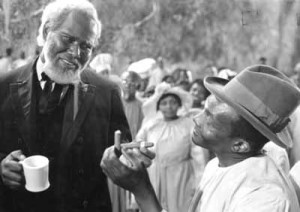The Green Pastures imagines an eternal fish-fry-picnic in a Heaven inhabited only by African Americans. It’s a faithful adaptation of Ol’ Man Adam, Roark Bradford’s racist version of the Old Testament episodes told from a supposed African American perspective.
There are three versions of The Green Pastures, all by White men: the book by Roark Bradford, the play by Marc Connelley, and the film directed by Connolly and Keighley. In Bradford’s text, God is a White plantation master wearing a crown. In the film, God is a cigar-smoking African American.

“Bi’ld” custard and a ten cent” seegar.” Rex Ingram as De Lawd
The story’s context is explained by a Preacher in his Sunday bible school class. He introduces the children to the image of Heaven as a place of picnicky pleasures: “Sho, dey had the nicest kind of picnics. Dey probably had fish frys, wid b’ild custard and ten cent seegars for the adults. God gives us human lotsa ideas about havin’ good times. Maybe dey were things he’d seen de angels do. Yes, sire, I bet dey had a fish fry every week.” Thus Heaven!
Heaven’s portrayal begins with an array of African American angels’ visual presence with white wings dressed in brightly colored robes preparing for their eternal fish-fry picnic. On a bank of puffy white clouds (like cotton balls), angelic fishers sit waiting with their rods. Below, under a canopy of live oaks on the great lawn, preparations for the fish fry are in progress. The scene suggests an Ante-bellum plantation mansion surrounded by a white picket fence replacing the traditional Pearly Gates.

Connelly’s accepted Bradford stereotyping and confused inherently racist fiction with real African Americans. It’s an example of unintentional racism. “The Green Pastures,” Connelly wrote, “is an attempt to present certain aspects of a living religion in terms of its believers. The religion is that of thousands of Negroes in the Deep South. With terrific spiritual hunger and the greatest humility, these untutored black Christians—many of whom cannot even read the book which is the treasure house of their faith—have adapted the contents of the Bible to the consistencies of their every-day lives.”
Maybe a pile of explanations ought to be written explaining this mishmash? View the film and see it for yourself.
See Marc Connelly’s and William Keighley’s The Green Pastures (1936). The screenplay by Marc Connelly is based on Roark Bradford’s Ol’ Man Adam (1928) and Marc Connelly. The Green Pastures: A Fable (1929); Roark Bradford. Ol’ Man Adam an’ His Chillun, Being the Tales They Tell about Time When the Lord Walked the Earth Like a Natural Man. Illustrated by A.B. Walker. New York: Harper Brothers, 1928; Marc Connelly. The Green Pastures: A Fable Suggested by Roark Bradford’s Southern Sketches “Ol’ Man Adam an’ His Chillun.” New York: Farrar & Rinehart, 1930; Adele Reinhartz. The Bible and Cinema: Fifty Key Films. Abingdon, Oxon: Routledge, 2012; Text of The Green Pastures: A Fable (1929); Brooks Atkinson. “New Negro Drama of Sublime Beauty.” The New York Times (February 27, 1930).

